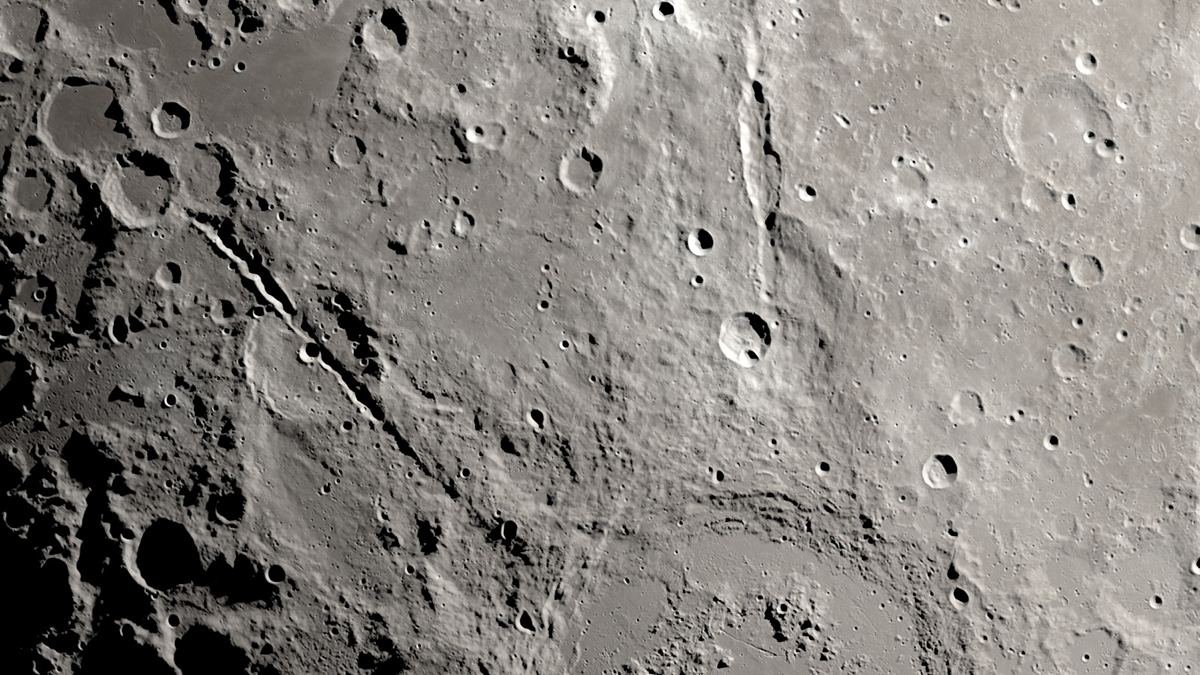About 3.81 billion years ago, a giant impactor rocked the Moon’s south pole. It formed the Schrödinger impact basin, which remains clearly visible today.
Astronomers recently found that two extremely deep and long valleys extending away from the crater were formed rapidly by pieces of rock flung outward during the impact.
The debris carved valleys “as big as the Grand Canyon on Earth. But instead of being formed during millions of years, they were formed within 10 minutes.”
“They reimpact the surface—boom, boom, boom, boom—and they form this line of individual craters,” said Danielle Kallenborn, a planetary scientist at Imperial College London and a coauthor of a study outlining the results published in Nature Communications. The debris carved valleys “as big as the Grand Canyon on Earth,” Kallenborn said. “But instead of being formed during millions of years, they were formed within 10 minutes.”
The debris pattern spreads away from sites where NASA’s Artemis mission plans to explore, suggesting that any samples collected there would be less likely to be from the impactor and more likely to be from the Moon itself.
Grand Canyons
The lunar south pole is dominated by the 4.3-billion-year-old South Pole–Aitken basin, among the largest impact craters in the solar system at 2,500 kilometers across. At its edge sits the smaller but still impressive Schrödinger basin, measuring 320 kilometers wide.
The two clearly visible valleys, Vallis Schrödinger and Vallis Planck, extend away from the northwestern edge of the Schrödinger basin. Each appears to be composed of a chain of so-called secondary craters—the result of rocks being thrown from the crater when the main impactor struck. Kallenborn and her colleagues identified 15 secondary craters in Vallis Schrödinger and slightly more in Vallis Planck.
The valleys are 270–280 kilometers long and 2.7–3.5 kilometers deep—about half the length of the Grand Canyon and twice as deep.
A wall of Vallis Planck appears to have partially collapsed following the valley’s formation, whereas Vallis Schrödinger has remained more intact. “The impact events generated rather steep-walled canyons,” said David Kring, a planetary scientist at the Lunar and Planetary Institute in Texas and a study coauthor. “In the case of Vallis Planck, the walls were unable to stay standing.”
“You could look and see them flying through the air.”
In modeling debris patterns from the impact, the researchers estimated the ejecta would have reached speeds of 3,420–4,610 kilometers per hour as the shock wave from the initial impact, millions of times more powerful than the atomic bomb dropped on Hiroshima, expanded outward.
On the bases of the distances of individual craters in each valley from the center of Schrödinger Crater, the team calculated that the pieces of debris took 5–15 minutes to reach their impact sites. “It is quite fast,” Kallenborn said. “You could look and see them flying through the air.”
Kelsi Singer, a planetary scientist at the Southwest Research Institute in Colorado who was not involved in the research, said secondary crater chains like this exist elsewhere in the solar system. One example is Falsaron Crater on Saturn’s moon Iapetus, which has two clear lines extending away from it. “They’re pretty similar,” she said.
Why an impact would produce a straight line of secondary impact craters is unclear, however.
Impactor Angle
The orientation of the two valleys suggests the impactor was headed north-northwest at an angle of less than 45° from the surface when it struck, according to the authors. The majority of secondary debris, including the rocks that formed the valleys, would therefore have been directed away from the Moon’s south pole.
NASA plans to land astronauts back on the Moon this decade, targeting regions south of Schrödinger. “Most of the ejecta was ejected north, which is away from the Artemis exploration zone,” Kallenborn said. “That’s good news” because any rocks collected are more likely to be older lunar rocks, perhaps even fragments of the Moon’s original crust, rather than pieces of the more recent impactor.
The Schrödinger basin was formed relatively late in the evolution of the early solar system. Scientists are more eager to examine rocks that took shape closer to the Moon’s formation 4.5 billion years ago and that might be present in the planned landing zones for Artemis missions.
“They’re more interested in sampling this [early material],” Kallenborn said. “It tells you more about the very early times of the Earth-Moon formation impact event and so on.”
However, there is still interest in sampling the Schrödinger ejecta too. It is “one of the last great basin-forming impact events that shaped the Moon,” Kring said, so examining a sample of it back on Earth could help us more precisely date the impact. “We still debate the magnitude and duration of that period of early solar system bombardment.”
—Jonathan O’Callaghan (@astrojonny.bsky.social), Science Writer

